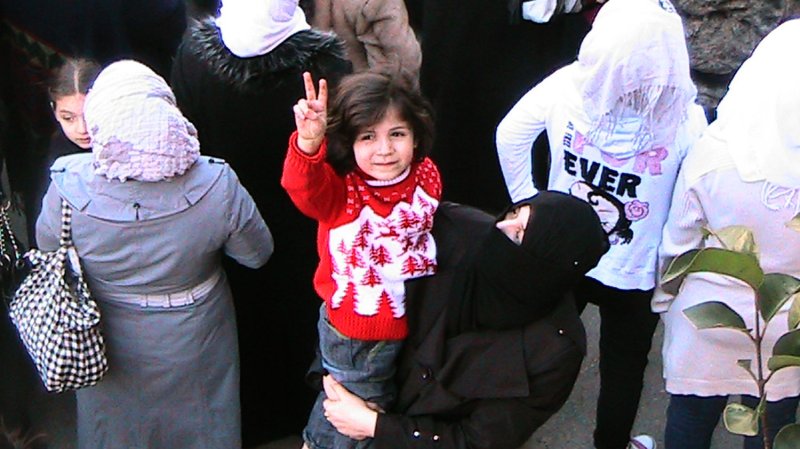Women protest against the government in the Al-qsoor neighborhood of Homs, Syria, on March 19, 2012. UPI |
License Photo
BEIRUT, Lebanon, June 21 (UPI) -- Syrian rebels seem to be gaining ground in their increasingly bloody 15-month-old uprising to unseat President Bashar al-Assad and his minority Alawite regime.
That's probably because they're getting more and more help from outside, arms funded by Saudi Arabia and Qatar, two of the strongest advocates of removing Assad, and probably Turkey as well.
Meantime, the rebel troops, mostly defectors from the regime's military, appear to be getting on-the-job training by jihadist veterans and no doubt intelligence on Syrian army movements from the United States and NATO in enclaves they now control in northern and western Syria.
That's a new development that underlines the rebels' growing capabilities and their ability to stand up to the regime's artillery and armor.
Military analysts say that recent bombings against key regime targets and other operations against Assad's forces, which outgun and outnumber the rebels, have shown a degree of proficiency and planning that hadn't been evident before.
The bombings, in particular those against heavily guarded Syrian intelligence facilities and other symbols of the regime, demonstrate how skills in unconventional warfare developed by the Palestinians in the 1970s, through Hezbollah in the 1980s and al-Qaida since the late 1990s have progressed.
In those decades, counterinsurgency specialists could track particular bomb making techniques to individual bomb makers who had been trained in what was then Marxist South Yemen, Libya, Syria, Iraq, Lebanon and after 1979 in Iran and later Afghanistan as well.
Explosively formed penetrators that al-Qaida used with lethal effect against U.S. forces during the Iraq War, along with Iranian-backed Shiite "Special Groups" groups, have been emerging in Syria, indicating that veterans of that conflict are aiding Syrian rebels.
"There are many ways that one can judge the degree of foreign support that a militant group is receiving," observed the U.S. global security consultancy Stratfor.
"The indicators include anything from uniforms to assault rifles to the presence of increasing numbers of anti-tank guided missiles and man-portable air defense systems.
"But more subtle indications, such as those involving IED components and bomb making skills should not be overlooked."
A case in point was the death in April of a senior Lebanese terrorist, Abdel Ghani Jawhar of Fatah al-Islam, an offshoot of al-Qaida with whom Damascus once flirted.
Jawhar, an explosives expert, was killed planting a bomb in the Syrian town of Qusair, 25 miles from the Lebanese border and then dominated by the rebels.
Jawhar and longtime associate Walid Boustani, another Lebanese, were among a group of about 30 jihadists who sneaked into Syria from Lebanon in March, security sources said.
They reported that Jawhar, one of Fatah al-Islam's leaders, was killed as he prepared a bomb to hit Syrian troops seeking to move into Qusair.
He had been instructing untrained Syrian fighters how to make bombs and planted dozens himself that took a toll on Syrian forces before he was killed.
"There are dozens of these guys, all seasoned veterans, who're passing on their skills," one Western intelligence official observed.
These are all Sunni fighters, joining a conflict that's shaping up to be a sectarian war between the Iranian-backed Alawite minority and Sunnis who comprise 75 percent of Syria's population of 22.5 million.
Al-Qaida veterans from Iraq are also reported to be moving into Syria, while Shiite militiamen loyal to Iranian-backed cleric Moqtada al-Sadr are going to support the Damascus regime.
Turkey's intelligence services are reported to be all over northern Syria, alongside Saudis liaising with opposition forces and CIA operatives as well scoping out the lay of the land and assessing the rebels' capabilities.
The FSA would appear to have an unknown quantity of anti-tank missiles, though most of these were probably stolen from Syrian army depots, or carried away by defectors.
In recent weeks, rebel video footage has shown burned-out army tanks and armored personnel carriers apparently destroyed by the FSA fighters, an almost impossible feat a few weeks ago.
The regime's recent deployment of helicopter gunships against the rebels and their civilian supporters is likely to result in the Saudis and their friends shipping man-portable surface-to-air missiles to the rebels, escalating the violence.
Thousands of Soviet-era SAMs stolen from armories in Libya during the 2011 civil war there are reported to be available on the black market for the highest bidder.





